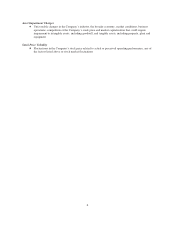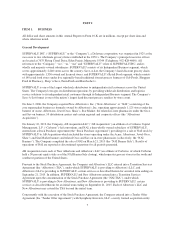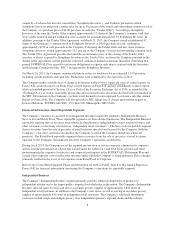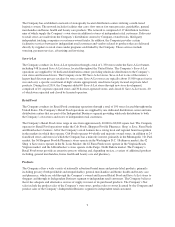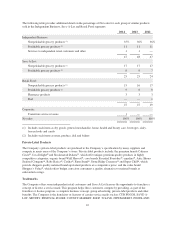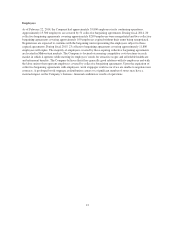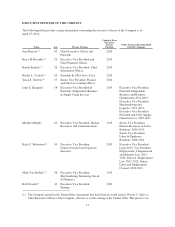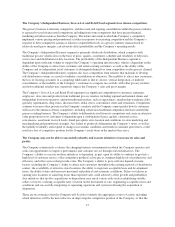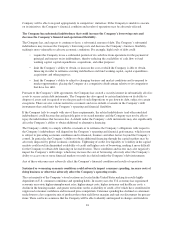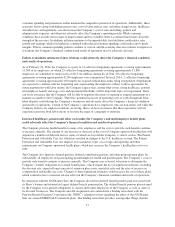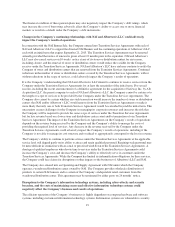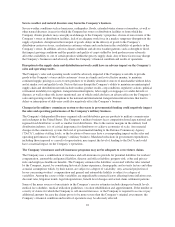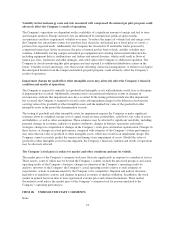Albertsons 2014 Annual Report Download - page 18
Download and view the complete annual report
Please find page 18 of the 2014 Albertsons annual report below. You can navigate through the pages in the report by either clicking on the pages listed below, or by using the keyword search tool below to find specific information within the annual report.Company will be able to respond appropriately to competitors’ initiatives. If the Company is unable to execute
on its initiatives, the Company’s financial condition and results of operations may be adversely affected.
The Company has substantial indebtedness that could increase the Company’s borrowing costs and
decrease the Company’s financial and operational flexibility.
The Company has, and expects to continue to have, a substantial amount of debt. The Company’s substantial
indebtedness may increase the Company’s borrowing costs and decrease the Company’s business flexibility,
making it more vulnerable to adverse economic conditions. For example, high levels of debt could:
• require the Company to use a substantial portion of its cash flow from operations for the payment of
principal and interest on its indebtedness, thereby reducing the availability of cash flow to fund
working capital, capital expenditures, acquisitions, and other purposes;
• limit the Company’s ability to obtain, or increase the cost at which the Company is able to obtain,
financing in order to refinance existing indebtedness and fund working capital, capital expenditures,
acquisitions and other purposes;
• limit the Company’s ability to adjust to changing business and market conditions and to respond to
market opportunities, placing the Company at a competitive disadvantage relative to its competitors
that have less debt.
Pursuant to the Company’s debt agreements, the Company has created a security interest in substantially all of its
assets to secure certain debt instruments. The Company has also agreed to certain limitations on its ability to
dispose of assets and is required to use the proceeds of such dispositions to pay down its debt, subject to certain
exceptions. There are also various restrictive covenants and cross-default covenants in the Company’s debt
instruments that could limit the Company’s operating and financial flexibility.
If the Company fails to comply with any of these requirements, the related indebtedness (and other unrelated
indebtedness) could become due and payable prior to its stated maturity and the Company may not be able to
repay the indebtedness that becomes due. A default under the Company’s debt instruments may also significantly
affect the Company’s ability to obtain additional or alternative financing.
The Company’s ability to comply with the covenants or to refinance the Company’s obligations with respect to
the Company’s indebtedness will depend on the Company’s operating and financial performance, which in turn
is subject to prevailing economic conditions and to financial, business and other factors beyond the Company’s
control. In particular, the Company’s ability to obtain additional financing through the capital markets may be
adversely impacted by global economic conditions. Tightening of credit, low liquidity or volatility in the capital
markets could result in diminished availability of credit and higher costs of borrowing, making it more difficult
for the Company to obtain debt financing on favorable terms. These conditions and factors may also negatively
impact the Company’s debt ratings, which may increase the cost of borrowing, adversely affect the Company’s
ability to access one or more financial markets or result in a default under the Company’s debt instruments.
Any of these outcomes may adversely affect the Company’s financial condition and results of operations.
Sustained or worsening economic conditions could adversely impact consumer spending, increase costs of
doing business or otherwise adversely affect the Company’s operating results.
The vast majority of the Company’s store locations are located in the United States making its results highly
dependent on U.S. consumer confidence and spending habits. In recent years, the U.S. economy has experienced
economic recession, higher unemployment rates, higher energy costs, higher insurance and healthcare costs, a
decline in the housing market, and greater restrictions on the availability of credit, all of which have contributed to
suppressed consumer confidence and increased price competition. Consumer spending has declined as consumers
trade down to a less expensive mix of products that often yield lower margins and seek out discounters for grocery
items. There can be no assurance that the Company will be able to identify and respond to changes and trends in
16


